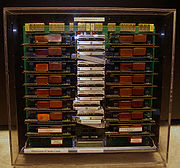
JUGENE
Encyclopedia


Supercomputer
A supercomputer is a computer at the frontline of current processing capacity, particularly speed of calculation.Supercomputers are used for highly calculation-intensive tasks such as problems including quantum physics, weather forecasting, climate research, molecular modeling A supercomputer is a...
built by IBM
IBM
International Business Machines Corporation or IBM is an American multinational technology and consulting corporation headquartered in Armonk, New York, United States. IBM manufactures and sells computer hardware and software, and it offers infrastructure, hosting and consulting services in areas...
for Forschungszentrum Jülich in Germany. It is based on the Blue Gene/P and is the successor to the JUBL based on an earlier design. It was at the introduction the second fastest computer in the world. It is currently the ninth fastest computer in the world according to TOP500
TOP500
The TOP500 project ranks and details the 500 most powerful known computer systems in the world. The project was started in 1993 and publishes an updated list of the supercomputers twice a year...
. The computer is owned by the Institute "Jülich Supercomputing Centre" (JSC) and the Gauss Centre for Supercomputing
Gauss Centre for Supercomputing
The Gauss Centre for Supercomputing is a research institute and a supercomputer center in Germany.-See also:* TOP500* High Performance Computing Center, Stuttgart* Supercomputing in Europe-External links:*...
.
With 65,536 PowerPC 450 cores, clocked at 850 MHz and housed in 16 cabinets the computer reaches a peak processing power of 222.8 TFLOPS
FLOPS
In computing, FLOPS is a measure of a computer's performance, especially in fields of scientific calculations that make heavy use of floating-point calculations, similar to the older, simpler, instructions per second...
(Rpeak). With an official Linpack
LINPACK
LINPACK is a software library for performing numerical linear algebra on digital computers. It was written in Fortran by Jack Dongarra, Jim Bunch, Cleve Moler, and Gilbert Stewart, and was intended for use on supercomputers in the 1970s and early 1980s...
rating of 167.3 TFLOPS (Rmax) JUGENE took second place overall and is the fastest civil/commercially used computer in the TOP500
TOP500
The TOP500 project ranks and details the 500 most powerful known computer systems in the world. The project was started in 1993 and publishes an updated list of the supercomputers twice a year...
list of November 2007.
The computer was financed by Forschungszentrum Jülich, the State of North Rhine-Westphalia
North Rhine-Westphalia
North Rhine-Westphalia is the most populous state of Germany, with four of the country's ten largest cities. The state was formed in 1946 as a merger of the northern Rhineland and Westphalia, both formerly part of Prussia. Its capital is Düsseldorf. The state is currently run by a coalition of the...
, the Federal Ministry for Research and Education as well as the Helmholtz Association of German Research Centres. The head of the JSC, Thomas Lippert, said that "The unique thing about our JUGENE is its extremely low power consumption compared to other systems even at maximum computing power". A Blue Gene/P-System should reach about 0.35 GFLOPS/Watt
Watt
The watt is a derived unit of power in the International System of Units , named after the Scottish engineer James Watt . The unit, defined as one joule per second, measures the rate of energy conversion.-Definition:...
and is therefore an order of magnitude more effective than a common x86 based supercomputer for a similar task.
In February 2009 it was announced that JUGENE would be upgraded to reach petaflops performance in June 2009, making it the first petascale
Petascale
In computing, petascale refers to a computer system capable of reaching performance in excess of one petaflop, i.e. one quadrillion floating point operations per second. The standard benchmark tool is LINPACK and Top500.org is the organisation which tracks the fastest supercomputers...
supercomputer in Europe.
On May 26, 2009, the newly configurated JUGENE was unveiled. It includes 294,912 processor cores, 144 terabyte
Terabyte
The terabyte is a multiple of the unit byte for digital information. The prefix tera means 1012 in the International System of Units , and therefore 1 terabyte is , or 1 trillion bytes, or 1000 gigabytes. 1 terabyte in binary prefixes is 0.9095 tebibytes, or 931.32 gibibytes...
memory, 6 petabyte
Petabyte
A petabyte is a unit of information equal to one quadrillion bytes, or 1000 terabytes. The unit symbol for the petabyte is PB...
storage in 72 racks. With a peak performance of about one PetaFLOPS
FLOPS
In computing, FLOPS is a measure of a computer's performance, especially in fields of scientific calculations that make heavy use of floating-point calculations, similar to the older, simpler, instructions per second...
, it was at the time the third fastest supercomputer in the world, ranking behind IBM Roadrunner and Jaguar. The new configuration also incorporates a new water cooling system that will reduce the cooling cost substantially.
The two front nodes of JUGENE are operated with SUSE Linux Enterprise Server
SUSE Linux Enterprise Server
SUSE Linux Enterprise Server is a Linux distribution supplied by SUSE and targeted at the business market. It is targeted for servers, mainframes, and workstations but can be installed on desktop computers for testing as well. New major versions are released at an interval of 3-4 years, while...
10.

